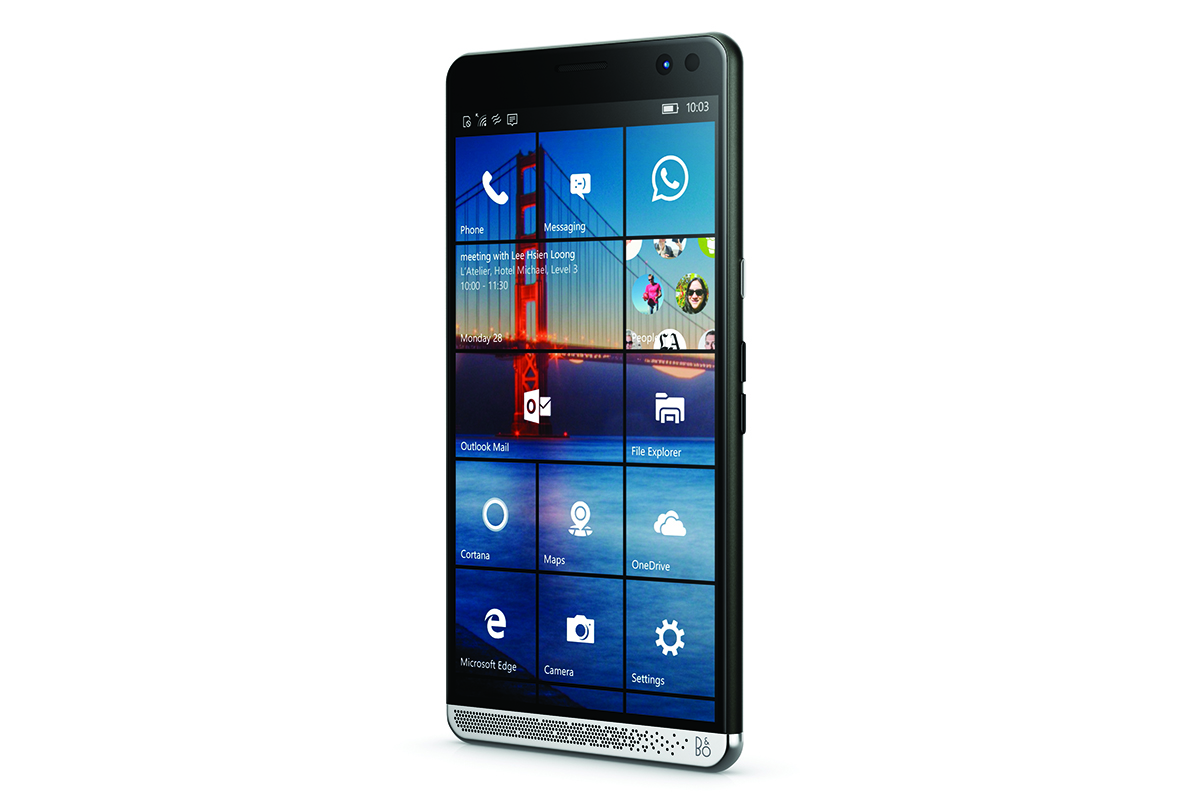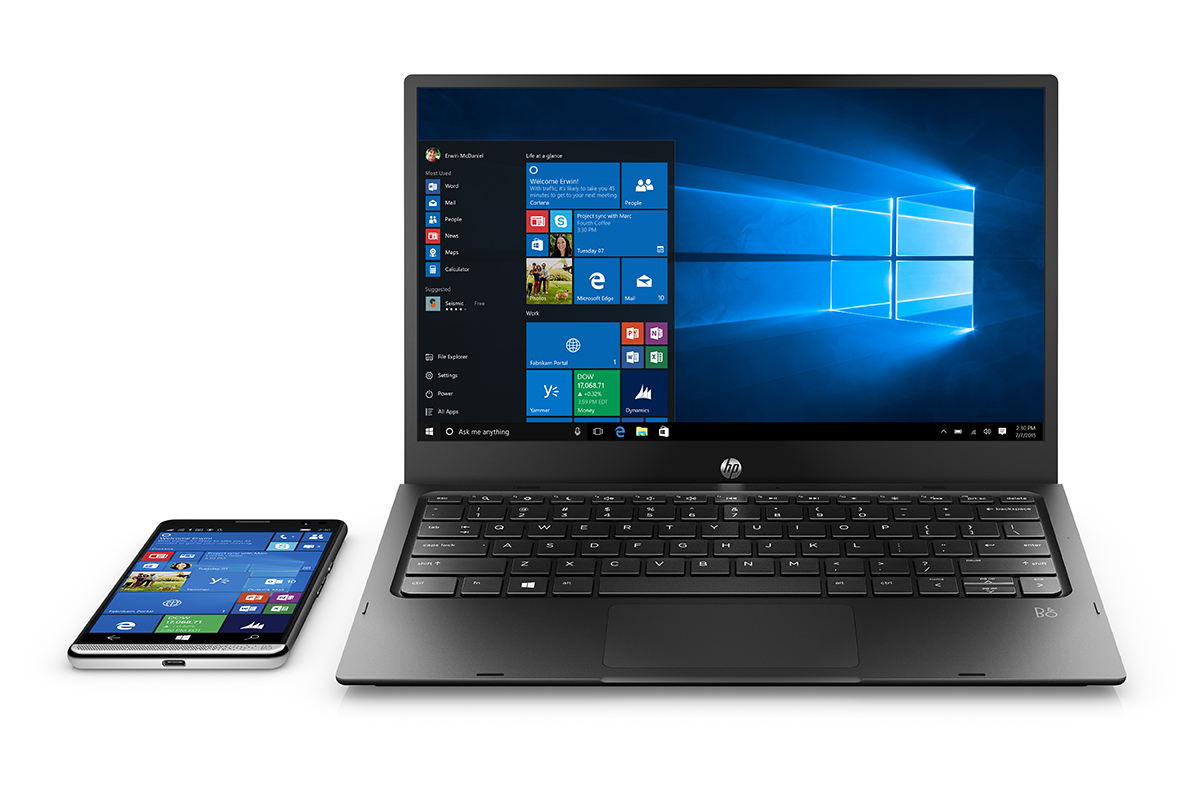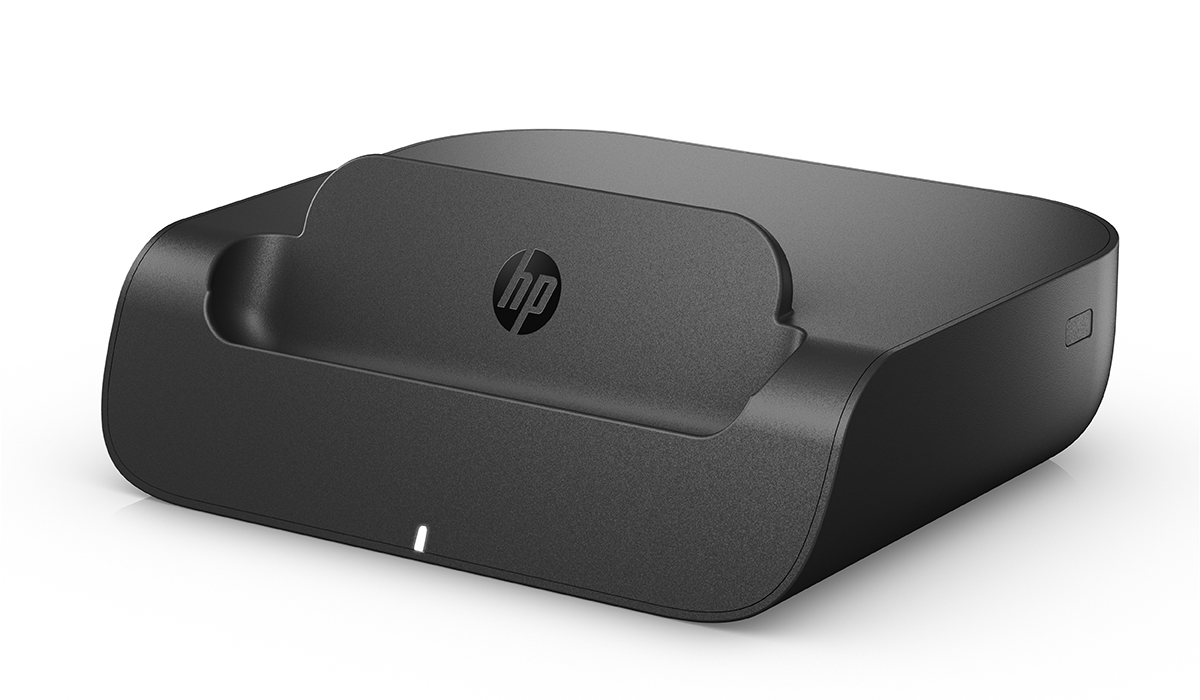HP Wants Back In: The Elite X3 Windows 10 Smartphone And 'Dumb' Laptop
Remember those HP smartphones? You probably don’t, because HP was not exactly a winner in the early days of mobile hardware. Suffice it to say, HP almost entirely exited the smartphone business, and hard, after the Palm experiment failed a few years ago.
But that was then and this is now, and the mobile business has changed dramatically since then, with one of most notable mobile trends being a convergence of smartphones, PCs and productivity. HP is not just trying to capitalize that trend--it seeks to define it, and it wants to do so with the Elite X3 smartphone, a “dumb” laptop shell, and a desktop dock.
At Build last spring, Microsoft announced that Windows 10 would run on Windows Phones with Universal Apps, and that you could use those phones with a Display Dock to connect peripherals and show the phone’s contents on a monitor, with the formatting of the apps befitting the larger display size.
Microsoft itself has proven that this works, with the Lumia 950 and the Display Dock, and companies such as Acer appear to be jazzed about the idea as well. HP, though is -- to hear its product reps tell it -- all in. It’s also the first company to employ the “dumb” clamshell concept (that is, the smartphone somehow docks into a laptop shell and powers the display) with a device that actually may have enough internal horsepower to work.
The Elite X3
So named because of its triple-threat raison d'être, the HP Elite X3 is by itself a high-end smartphone, but it also can function as the engine of a laptop-style device (the “HP Mobile Extender”), and you can park it in the HP Desk Dock and display the screen on a larger external monitor.
In order to pull this off, the Elite X3 needs some killer specs, and HP spared no expense in that department. The 5.96-inch AMOLED display is 2560x1440, and there’s 4 GB of LPDDR4 SDRAM and 64 GB eMMC 5.1 storage (with the capability for up to a whopping 2 TB of storage via the microSD card slot). In the Elite X3’s heart beats the Qualcomm Snapdragon 820 SoC (2.15 GHz, quad-core) with an Adreno 530 GPU. (On the SoC, HP is not dogmatic, though; a representative told us that they would consider switching to an Intel Atom chip, but for now they wanted optimal performance and felt that the 820 was the best choice.)
The front 8MP camera has an Iris camera (hello, Windows Hello) that can capture and then stitch two images together in the software for ostensibly a better photo. Both it and the rear-facing 16MP camera shoot in FHD. Speaking of security measures, there’s also a fingerprint reader, which brings the number of biometric authentication methods on this phone to two. There is a USB Type-C port, but all we know about it at this point is that it’s USB 3.0.
Get Tom's Hardware's best news and in-depth reviews, straight to your inbox.
The Elite X3’s body is mostly polycarbonate, but it does have a healthy amount of metal trim, which gives it some durability. The front of the phone has a striking “holy” speaker grill design by Bang & Olufsen, which actually evokes the “pogo pins” on the bottom of the device. These allow HP partners to develop dedicated, add-on capabilities (called “jacket extensions”) for the medical field, POS applications and so on. There’s a large-capacity 4,150 mAh battery powering the whole thing.
And of course, it runs Windows 10 Mobile (I guess we’re back to calling it that again?) and has Continuum. (Have a look at the rest of the specs at the botton of this article.)
“Accessories” Is An Inadequate Term
We’re typically not much interested in “accessories,” but the term hardly applies to the items you’ll be able to buy to go with the Elite X3.
Details are rather light thus far, but the aforementioned HP Mobile Extender (which HP is affectionately calling “MeDock”) is like a robot that just needs you to plug in a soul. We aren’t really sure at this point how the phone docks into/with it, but given that HP described it as a sort of thin client, we’d guess that you’re just connecting the phone to it with a cable, and/or wirelessly.
It has a 12.5-inch diagonal “near-borderless” display and a 48 wH battery all its own. Obviously, it has a keyboard and touchpad, as well. It also has at least one USB Type-C port that supports Power Delivery, meaning one device can charge the other while connected.
The HP Desk Dock is less titillating than the Mobile Extender, but it’s no less compelling. It follows some of the same basic ideas as Acer’s yet-to-be-named dock for its Liquid Jame Primo handset in that the Elite X3 sits propped upright in a little holder on the desk. A USB Type-C cable connects the dock to a large display, and you can connect at least two other devices via the two USB Type-A ports. The dock also has a DisplayPort, an Ethernet port and a “rapid charging” feature. Via Continuum, the connected phone shows apps on the large display in a desktop-looking environment.
HP Workspace And The Continuing App Kludge
The primary criticism leveled at Windows Phone has always been the poor app ecosystem relative to what iOS and Android enjoy. Microsoft has tackled that problem head-on recently, though with mixed success.
The concept of Universal Apps -- that is, applications like Word and Outlook that share common code and can run on all manner of systems with Windows 10 -- was a victory, to be sure. However, the Microsoft’s intiatives to make it easy to port Android and iOS apps onto Window 10 Mobile seem to have little traction at this point. Further, you can’t run legacy x86 applications on Windows 10 Mobile.
To solve this app problem, HP went to the well it knows in the enterprise: virtualization. With its HP WorkSpace, the company can run legacy x86 applications in a Virtual Desktop Infrastructure (VDI) on the phone. WorkSpace offers SSO and full keyboard and mouse support when the device is docked, too. For everything else, there are plenty of Universal Apps to pick from.
It makes sense; enterprise users are accustomed to virtualizing legacy apps anyway, so this should be a logical extension of that paradigm. However, you can’t run just any legacy program. HP WorkSpace maintains a curated list of x86 programs.
Assuming the virtualization works as smoothly as HP hopes, though, critics of the app problems on Windows 10 Mobile still aren’t necessarily silenced. The rather kludgy mess of ways to get apps isn’t winning too many users to Windows 10 Mobile; there are app store apps, Universal apps, apps ported from other OSes, and legacy applications running in a virtual machine. If all of those methods work flawlessly, then it’s pretty brilliant, but if they create confusion and end up with performance issues, then it’s a disaster. The jury is still out on which it is, but HP has decided that it’s close enough to the former.
By the way, if you’re getting a sneaking suspicion that this device is aimed primarily at the business space, your hackles are accurate. In our briefing on the Elite X3 and its related technologies HP reps didn’t really have a clear answer when someone asked if this would all be available for consumer. In essence, it probably will be, we guess.
Availability is slated for August. There is no pricing information to share at this time, but expect to pay over $1,000, at least for a bundle that includes the Elite X3 itself, the Mobile Extender and the Desk Dock. The accessories, though, will be mainly sold separately; you can still just buy the Elite X3 because it’s a high-end Windows 10 smartphone.
| Header Cell - Column 0 | HP Elite X3 |
|---|---|
| Display | 5.96-inch (2560x1440) AMOLED multitouch, Corning Gorilla Glass 4 , anti-reflectivecoating |
| SoC | Qualcomm Snapdragon 820 MSM8996 (2.15 GHz, quad-core) |
| GPU | Adreno 530 |
| RAM | 4 GB LPDDR4 |
| Storage | 64 GB eMMC 5.1, up to 2 TB microSD |
| Cameras | Front: 8MP FHD w/ Iris cameraRear: 16MP FHD |
| Audio | -Stereo speakers (one w/ earpiece)-Integrated omni-directional mics w/ HP Noise Cancellation Software (x3)-External mic (from headsetjack) -Snapdragon Audio+ support-Audio by B&O PLAY |
| Connectivity | -4G LTE-A w/ carrier aggregation-802.11a/b/g/n/ac (2x2) Wi-Fi/BT 4.0 LE combo (Miracast supported)-NFC |
| Ports | -Headphone jack -Dual nano SIM (or nano SIM + microSD) via 3-in-2 tray-Pogo pins-USB Type-C (USB 3.0) |
| Sensors | -Ambient light sensor + proximity combo -Accelerometer + gyro-eCompass, pressure-Hall effect -GPS |
| Security | -Iris recognition (front cam) and fingerprint reader-FIPS 140-2 cryptography-Qualcomm Secure Boot, 128-bit key Unified Image Encryption, 256-bit key Full Disk Encryption, Anti rollback, fTPM 2.0 security-Windows 10 includes 128 key Bitlocker encryption and Enterprise grade VPN |
| Battery | 4,150 mAh Li-ion polymer |
| Software | HP Workspace, HP Device Hub, HP Registration and device onboarding, Adobe PDF Reader |
| Dimensions | -83.5 x 7.8 x 161.8 mm -Starting at 195g (0.43 lb) |
| Misc. | IP 67 water- and dust-proof, MIL-STD 810G (has not passed either yet, apparently) |
| OS | Windows 10 Mobile |
| Availability | August 2016 |
| Pricing | TBD, accessories will be sold separately and in bundles |
Seth Colaner is the News Director for Tom's Hardware. Follow him on Twitter @SethColaner. Follow us on Facebook, Google+, RSS, Twitter and YouTube.
Seth Colaner previously served as News Director at Tom's Hardware. He covered technology news, focusing on keyboards, virtual reality, and wearables.
-
atheus This. Needs. To. Happen.Reply
And it needs to be polished to perfection. If we get to the point of having a Windows 10 phone that handles all the normal computing tasks with access to essentially any software you care to use, this becomes an extremely attractive item. Plus the idea of a laptop shell you can just plug in and use while on the go or in the classroom? Brilliant. There are so many people who could (and should) just skip the desktop PC entirely with something like this. I hope they continue to pursue this idea! -
LuxZg Do the same with Atom + "normal" W10 and I'm in! I expected MS to do it with once Continuum was first talked of, but so far nothing... Why-oh-why? Alas, still we're so close yet - out of reach.Reply -
vaughn2k Before you can travel anywhere with mobile hardrives or thumb drives, but limited only to files and not functions. I'd say, a 'dumb laptop' and a 'dumb desktop', is a great idea.. and carry your phone everywhere...Reply -
g-unit1111 I used a Microsoft Lumia 950XL over the weekend and it's an incredibly solid phone, but it needs more app support to be able to compete with Android and iOS. This HP phone seems like it's even a step up from the 950. Maybe having more manufacturers onboard and offering solid hardware will encourage more app makers to develop for the WP10 mobile platform.Reply -
koss64 I take issue with the comment that HP didn't make any sensible smart phones before this,I fondly remember my iPaq 610 business messenger that ran Windows Mobile,the phone was solid and quick, only issue I had was that four years after I purchased it the cpu started overheating and caused all kinds of headaches. Im disappointed with this latest phone as it doesn't have a keyboard,im sorry I cant deal with a non physical keyboard,since my lg quantum's touch screen died I moved onto a lumia 520 and I just HATE not having a keyboard,so many typing errors...Reply -
TallestJon96 I'm just hoping that htc and Oculous are making a good margin on this, so that even if they dont sell much they can make some money. They better not be counting on these things to fly off the shelf. 2 years from now, when there are lots of games, a new revision comes out that is better and only $500-$700, and PC hardware has moved up a step, then more people will adopt it. Its a scary situtation where no games means no adoption, and no adoption means no games. But if it works, we could see some truely interesting new games, with the bigest technological change in games since real time 3-d rendering. Im cautiously optimistic despite the prices. Better to provide a kick ass experience at a high price now then to sell them for $300 and have it fade away 2 years from now. *fingers crossed*Reply -
alextheblue Now that sounds like a phone I'd like to have... hope Verizon pick this up since the bastages didn't pick up the 950 series.Reply
Maybe having more manufacturers onboard and offering solid hardware will encourage more app makers to develop for the WP10 mobile platform.
Well the beauty of UWP is that you can develop for the greater Win10 platform and use the same codebase.




